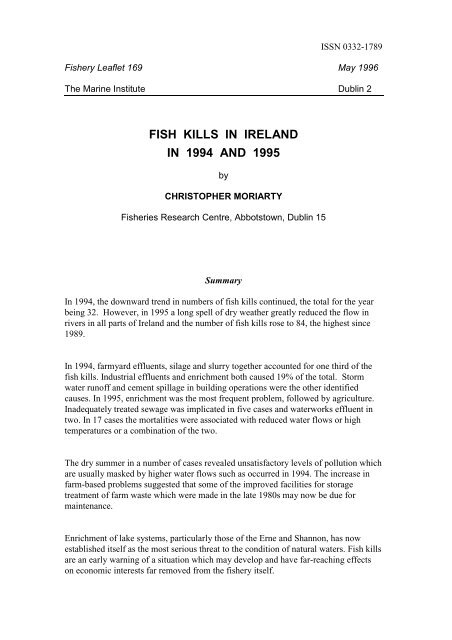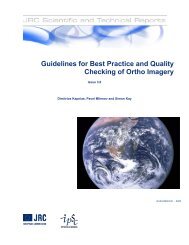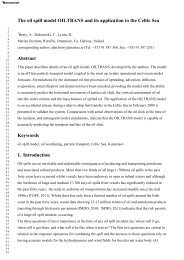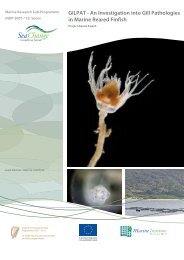CHRISTOPHER MORIARTY - Marine Institute
CHRISTOPHER MORIARTY - Marine Institute
CHRISTOPHER MORIARTY - Marine Institute
You also want an ePaper? Increase the reach of your titles
YUMPU automatically turns print PDFs into web optimized ePapers that Google loves.
ISSN 0332-1789Fishery Leaflet 169 May 1996The <strong>Marine</strong> <strong>Institute</strong> Dublin 2FISH KILLS IN IRELANDIN 1994 AND 1995by<strong>CHRISTOPHER</strong> <strong>MORIARTY</strong>Fisheries Research Centre, Abbotstown, Dublin 15SummaryIn 1994, the downward trend in numbers of fish kills continued, the total for the yearbeing 32. However, in 1995 a long spell of dry weather greatly reduced the flow inrivers in all parts of Ireland and the number of fish kills rose to 84, the highest since1989.In 1994, farmyard effluents, silage and slurry together accounted for one third of thefish kills. Industrial effluents and enrichment both caused 19% of the total. Stormwater runoff and cement spillage in building operations were the other identifiedcauses. In 1995, enrichment was the most frequent problem, followed by agriculture.Inadequately treated sewage was implicated in five cases and waterworks effluent intwo. In 17 cases the mortalities were associated with reduced water flows or hightemperatures or a combination of the two.The dry summer in a number of cases revealed unsatisfactory levels of pollution whichare usually masked by higher water flows such as occurred in 1994. The increase infarm-based problems suggested that some of the improved facilities for storagetreatment of farm waste which were made in the late 1980s may now be due formaintenance.Enrichment of lake systems, particularly those of the Erne and Shannon, has nowestablished itself as the most serious threat to the condition of natural waters. Fish killsare an early warning of a situation which may develop and have far-reaching effectson economic interests far removed from the fishery itself.
Fishery Leaflet 169 - 1996IntroductionThe leaflets in this series give a summary of reports on fish kills, most of which havebeen provided by the Environment Officers of the seven Regional Fisheries Boards,together with complementary reports from officials of local authorities. The fish killslisted are those which are presumed to be caused by pollution. Reports of dead fishwhich can clearly be ascribed to disease or illegal fishing are not included.Both numbers of fish and length of stream affected are usually approximations. It israrely possible to account for all fish killed in any incident because many sink to thebottom and cannot be counted. Similarly, the length of the stream in which fish died isdifficult to measure with certainty because dead fish can be carried downstreambeyond the limits of the polluted water.Major incidentsThe most serious incident in 1994 was in the River Lung near Ballaghadereen on 16thJune. An estimated 10,000 bream and roach were killed in a 5 km reach by organicwaste from an unknown source. Other major kills, in which 1,000 or more fish died,all affected trout and young salmon and resulted from a variety of causes: farmeffluent in two cases, a chemical spillage and a discharge from a sewage treatmentworks. The effects of the chemical spillage extended over more than 6 km of the AraRiver, Co. Tipperary. The major farm effluent incidents were in the Farneybridgeriver, extending for 8 km and the Finglasha River over 3 km. Details are given inTable 1.In 1995, although the number of incidents was high, major kills in the rivers wererelatively few, with four involving 1,000 or more fish. The greatest number was 4,000,killed by slurry in the Shournagh River. Slurry was implicated again in the River Erne.The other two major kills resulted from low water. Four serious incidents took place inlakes, one in the Shannon and three in the Erne lakes Oughter, Gowna and the InnerLake at Cootehill. All have been ascribed to enrichment of the water.Distribution and datesThe Southern and Northern Regions were the most seriously affected in 1994, but bothwere below the average for the 13 year period. The numbers of kills remained lowuntil summer, with only one in each of the months February, March and April and 3 inMay. The peak month was June with 10 incidents, after which the numbers fell offagain through July and August, with none in September. Most of the July incidentswere in the Northern Region but in the other months fish kills were distributedthroughout the country. Rainfall was relatively high throughout the summer and waterlevels were higher than usual.The total length of stream affected was 49 km, more than double the figure for 1993,although the numbers of fish kills were almost equal. In 1993 a much higherproportion of the kills took place in lakes so that a smaller number of incidents were in2
Christopher Moriarty: Fish kills in Ireland in 1994 and 1995flowing water. The average length of stream affected, however, was 35% higher thanin 1993 (Table2).At the end of April 1995, only two fish kills had been reported, followed by in May.Rainfall in April, May and June was well below average and stream flow had beengreatly reduced. July rainfall was relatively low and August and September were verydry. June and July both recorded the highest numbers of fish kills since 1989 andAugust the highest since 1983 when systematic recording began.The Eastern, Southern, Southwestern and Shannon Regions all had their highestnumbers of incidents since 1989. The Western Region was the only one with a figurebelow average. Northwestern was double the average and the Northern Region had itshighest number of incidents in the 13 year period, equal to that of 1987, the worst yearon record.The stream length affected was twice as high as in 1994, totaling 102 km. In theNorthwestern Region, there were four incidents and mortality extended over more than3 km in each, explaining the exceptionally high average.CausesEutrophication has remained the most serious problem. Other forms of farm-basedpollution increased sharply from the minimum they had reached in the previous year.Silage, however, which had been one of the most serious problems in the 1980s, was3
Fishery Leaflet 169 - 1996implicated only twice in 1984. The most serious problem was of run-off fromfarmyards. The greatest number of point-source problems in 1995 were alsoagriculture-based. Silage showed a serious increase, accounting for half the incidents.Slurry came next with a total of 5.In 1994 there were two kills resulting from faulty sewage treatment works and twofrom cement spillage. The numbers resulting from other causes remained low with noparticular change from previous years.This pattern changed in 1995 with the low water conditions. Deoxygenating camenext to agriculture in the number of fish kills caused. The heading is used to cover avariety of causes, all associated with low water. In some cases, high temperature wasconsidered the primary cause of death. In others, oxygen reduction resulted fromdense weed growth which takes up too much oxygen at night. A total of 17 killsresulted from one or other of these. Sewage was implicated in 7 cases, the highestscore since 1989. Accidental spills from factories, from swimming-pool andwaterworks flushing and from gravel digging all caused small numbers of fish kills.Such accidents often result from a lack of awareness of the risks to fish life involvedand can be eliminated with greater care.Rainfall and temperatureThe graphs in Figure 1 show dramatically the effect of prolonged summer drought onthe number of fish kills. High rainfall in summer is usually associated with coldweather and low water temperatures and adequate dilution of effluents in streams. Adry summer is almost invariably one of low flows and high temperature adds greatly tothe stress experienced by fish. Trout and salmon, above all, thrive in cold water. Infine weather, bright sun increases the temperature and the effect is exacerbatedbecause the streams are flowing slowly and are not being cooled by rain or by theusual supply of ground water. Oxygen is less soluble in warm water than in cold andtherefore a number of natural factors combine to make life very difficult for the fish.In some cases, the only cause of death appeared to be de-oxygenation or hightemperature or both.4
Christopher Moriarty: Fish kills in Ireland in 1994 and 1995This goes some way towards explaining the sudden rise in the numbers of fish kills in1995. From the point of view of environmental protection, the essential fact is that alevel of pollution which might pass un-noticed in wet weather will result in fish kills ina hot summer. Hot summers cannot be predicted in advance and therefore effluentcontrol must be rigidly enforced at all times.EutrophicationEnrichment of lake waters, from phosphates leached from farm land, continued to be aserious cause of problems and was the most frequently implicated. The evidence foreutrophication remains circumstantial because the situation is extremely complex. Thephosphates themselves do not make the water unsuitable for fish life. The problemcomes from a combination of factors. The availability of nutrients is a key factor incontrolling the growth of green and blue-green microscopic algae. Sunlight,temperature and wind are additional factors. In cold, cloudy conditions the algae areunable to multiply as freely as in bright weather when the water is warmer. Anexceptionally hot and dry summer, like that of 1995, provides ideal conditions for anexcessive bloom of algae. Strong winds help to circulate lake water, dispersing thealgal blooms and mixing any toxic products so that they are greatly diluted.In some cases of algal blooms, the oxygen level in the water is reduced partly by theliving algae at night, when they are not releasing oxygen by photosynthesis, and partlyby the decay of dead algal cells. In others, the algae release toxins into the water.Occasionally these kill dogs and cause skin irritation on bathers, besides harming fish.However, in many cases, there is no obvious cause-and-effect: daytime oxygen levelsare found to be close to normal and no toxins can be detected. The fish often showsigns of disease. However, stress caused by deterioration of the water quality isenough to causes large numbers of fish, already weakened, to succumb to diseasescaused by bacteria and parasites which are normally present in the water, but which donot affect un-stressed fish populations.The strongest argument in implicating ‘enrichment’ as the cause of fish kills is the factthat, in the course of the past twenty to thirty years, the phosphate content of the large5
Fishery Leaflet 169 - 1996lowland lakes has increased, algal blooms have become more frequent and thenumbers of fish kills in lakes have increased to an alarming degree. Changes in thenature of agriculture-based fish kills in the Northern Region, nearly all of which relateto the lakes of County Cavan, are shown in Figure 3. Point-source problemsdiminished rapidly after 1987 but have been gradually replaced by those caused byenrichment.Recent trends and their significanceThe very high number of fish kills in 1987 led to many important steps being taken toreduce the problems of water pollution. Farm wastes and silage, in particular, werecontained much more effectively than in the past. Apart from one blip in 1989,associated with a hot, dry summer, a very satisfactory downward trend in the numbersof fish kills was apparent (Figure 4). The sharp rise in 1995 was an important reminderthat the problems of pollution have not yet been solved. The low water conditions inmany cases revealed how damaging low levels of pollution can be under certainconditions. They drew attention to sewage treatment plants which were not workingefficiently and also served as a reminder of the damage that can be caused to fisheriesby inadequate control of flushing from swimming pools and water treatment worksand greater care is called for in tshi area. The most encouraging point here, however, isthat most of the problems have not increased seriously over the years.Farm-based problems, however, have increased steadily since 1993 and may need tobe given serious attention on the scale they received in 1987 if this trend is to bestopped. It seems possible that facilities which had been improved seven or eight yearsago may be falling into neglect again.Enrichment of lakes and, to a less obvious extent, of rivers remains the most seriousproblem. Table 2 shows the extent to which fish kills in lakes have increased innumbers since the 1980s. This trend became very noticeable in 1993 when the total of15 incidents in the Northern Region was four times the average of the preceding years.This trend was also apparent in the Shannon lakes in which there were 6 kills in thefour years 1986 to 1989 and 10 in 1992 to 1995. The problem abated in 1994 but wasserious again in 1995.6
Christopher Moriarty: Fish kills in Ireland in 1994 and 1995The argument that the lethal effects of excessive phosphate have not always beenclearly demonstrated is too dangerous to be maintained. Sub-lethal effects are plainlyevident while routine chemical analyses over many years have demonstrated theincreasing phosphate loading. The pattern of fish mortality, coinciding with the risephosphate in solution and frequent algal blooms, points very strongly to eutrophicationbeing the cause of the problems.if the numbers of fish kills in the Erne and Shannon lakes continue to increase, thestocks may become seriously depleted with a consequent reduction in income fromangling tourism. Even though the stocks themselves may not yet be under severethreat, the frequent appearance of dead, dying or distressed fish in popular anglingwaters presents a very serious negative image not only to anglers, but to all industrieswhich are enhanced by Ireland’s justifiable reputation as an unpolluted environment.The increasing mortalities of coarse fish must be taken as a clear early warning ofenvironmental degradation which, if not addressed, will have consequences far beyondthe welfare of the fishing industry.AcknowledgmentsThis leaflet is a summary of reports supplied by the Environmental Officers of theseven Regional Fisheries Boards. A number of additional reports have been made byCounty Council officials. The help of Trevor Champ, Central Fisheries Board and ofofficers involved and their advice on the presentation of this report is gratefullyacknowledged.Previous reportsEdward Fahy Leaflets 128 and 132 (1983 - 1985)Desmond McCarthy 141 and 143 (1986 - 1988 and summary 1969-87)Christopher Moriarty 146, 149, 157, 159 (1989 - 1993)7
















